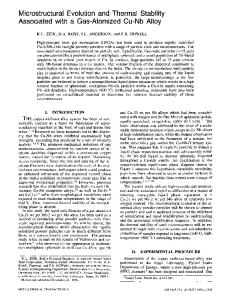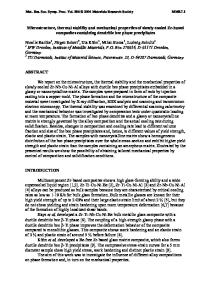Thermal oxidative stability of yttrium containing oligomeric silazanes with organoelement substituents and multiceramics
- PDF / 1,240,840 Bytes
- 8 Pages / 612 x 792 pts (letter) Page_size
- 9 Downloads / 288 Views
1503
Thermal oxidative stability of yttrium containing oligomeric silazanes with organoelement substituents and multiceramics on their basis O. G. Ryzhova,a P. A. Storozhenko,a K. N. Gerasimov,a P. A. Timofeev,b A. O. Kurishev,a A. Ya. Yakimova,a A. I. Drachev,a I. A. Timofeev,b M. G. Kuznetsovaa aState
Research Institute for Chemistry and Technology of Organoelement Compounds, 38 shosse Entiziastov, 105118 Moscow,Russian Federation. Tel.: +7 (495) 673 4953. Е- mail: [email protected] bJSC "Kompozit" 4 ul. Pionerskaya, 141070 Korolev, Moscow Region, Russian Federation. Tel.:+7 (495) 513 2343. Е-mail: [email protected]
Characteristics of thermal transformations of oligomeric silazanes with organoelement substituents at the N atoms (M-OESs) containing one element М = Y, Zr, or Hf or a pair of elements, viz., Zr and Y or Hf and Y, in air in the temperature range 200—1500 С were investigated. The introduction of yttrium into zirconium- or hafnium-containing oligosilazanes results in an increase in the mass loss at the stage of ceramization and to a decrease in the mass loss in the formed ceramics during subsequent stepwise heat treatment up to 1500 C. The combination of yttrium with hafnium or zirconium in M-OESs results in a synergistic effect of overall mass loss reduction. The (Zr, Y)-OES and (Hf, Y)-OES multiceramics outperform ceramics modified with one metal in this parameter. The obtained multiceramics is characterized by high thermo-oxidative stability in the temperature range 1100—1500 С. It is also found that yttrium-containing oligosilazane (Zr, Y)-OES exhibits oleophilic properties with respect to carbon materials. Key words: oligosilazanes with organoelement substituents, preceramic oligomers, impregnating compositions, ceramics of the SiCN composition.
Oligomeric silazanes with organoelement substituents (M-OESs), where М is Y in combination with a refractory metal (Ti, Zr, Hf, or Ta), are promising precursors of silicon nitride and carbonitride ceramics with the yields above 900 wt.%.1—7 Modification of preceramic oligosilazanes with formation of the Si—N—М fragments (М = Ti, Zr, Hf, Y, Ta)4—7 is an efficient method for increasing the thermal resistance of ceramic matrix composites (CMCs) since such precursors during pyrolysis form ceramic composites stable against oxidation. According to TGA data, the presence of the Si—N—М fragments in M-OESs increases the yield of the inorganic residue in the following order: Ti < Ta < Hf < Zr, which depends on the metal nature and its concentration.6 A specific feature of the pyrolysis of M-OESs under argon atmosphere is the formation of amorphous ceramics with uniform distribution of all elements.1,4—7 At that, formation of ceramic fibrous nanostructures occurs both on the surface and in the bulk of the multiceramics7 in the temperature range 850—1350 С. In previous studies,1,4—7 thermal transformations of M-OESs in inert atmosphere and in vacuum were explored. Thermal transformations of M-OESs in air are studied
much poorer, although M-OESs are components of CM
Data Loading...











